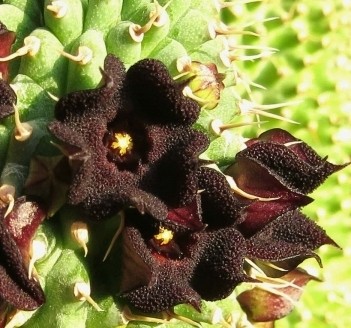Ceropegia pilifera pilifera
(Ceropegia pilifera pilifera)

Description
Hoodia is a genus of flowering plants in the family Apocynaceae, under the subfamily Asclepiadoideae, native to Southern Africa. One species of Hoodia in particular, Hoodia gordonii, has achieved a degree of fame and controversy, after being investigated for use as a possible appetite suppressant. The group was first described as a genus in 1844. Hoodia are stem succulents, described as "cactiform" because of their remarkable similarity to the unrelated cactus family. They have a branching, shrub-like form, and the largest species (Hoodia parviflora) can grow to the size of a tree — over 2 m (6 ft 7 in) in height. The flowers are extremely variable in size — from less than 1 cm, to almost 20 cm in diameter, depending on the species. Flowers appear in large numbers, always near the tops of the stems. Those of larger-flowered species (such as Hoodia gordonii) are often a papery pink-tan colour, plate-shaped, with an unpleasant smell to attract their fly pollinators. The smaller, darker flowers of some species have a far stronger and more unpleasant smell than the larger flowers. The genus Hoodia is restricted to the arid regions in the western part of southern Africa, ranging from western South Africa to central Namibia and as far north as southern Angola. It is especially common in the Namib desert and in the Orange River valley. Typical habitat is rocky slopes and open stone plains. Plants usually germinate in the shelter of bushes or rocks, but survive in the open as adult plants. Several of the small-flowered species of Hoodia were formerly in a separate genus, Trichocaulon ("ghaap"), but have been moved into the genus Hoodia, and the two groups are now synonymous. Phylogenetic studies have shown the genus Hoodia to be monophyletic, and most closely related to the stapeliad genus Lavrania. Marginally more distantly related is a sister branch of related genera including Larryleachia, Richtersveldia and Notechidnopsis. Hoodia gordonii is traditionally used by the San people (Bushmen) of the Namib desert as an appetite suppressant as part of their indigenous knowledge about survival in the harsh desert conditions. In 2006, the plant became internationally known, after a marketing campaign falsely claimed that its use as a dietary supplement was an appetite suppressant for weight loss. As of 2018, there is no high-quality clinical research showing that hoodia has actions as an appetite suppressant or is effective for weight loss.
Taxonomic tree:







